
views
- The domain of a function is the set of input values (x) for which the function produces an output value (y).
- Solve for the domain depending on things like whether there is a variable in the denominator or inside a radical sign.
- Notate the domain as 2 endpoints separated by a comma. Use brackets if the point(s) is included in the domain, or parentheses if not.
Learning the Basics
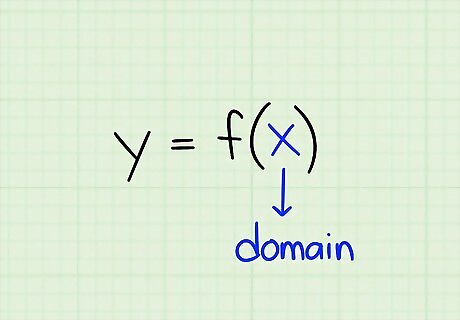
Learn the definition of the domain. The domain is defined as the set of input values for which the function produces an output value. In other words, the domain is the full set of x-values that can be plugged into a function to produce a y-value.
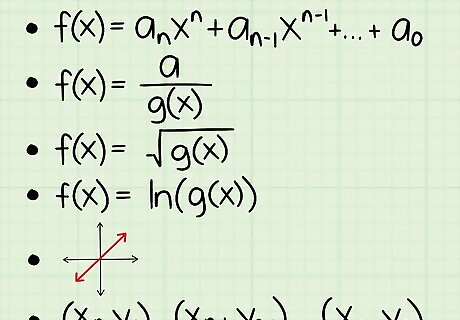
Learn how to find the domain of a variety of functions. The type of function will determine the best method for finding a domain. Here are the basics that you need to know about each type of function, which will be explained in the next section: A polynomial function without radicals or variables in the denominator. For this type of function, the domain is all real numbers. A function with a fraction with a variable in the denominator. To find the domain of this type of function, set the bottom equal to zero and exclude the x value you find when you solve the equation. A function with a variable inside a radical sign. To find the domain of this type of function, just set the terms inside the radical sign to >0 and solve to find the values that would work for x. A function using the natural log (ln). Just set the terms in the parentheses to >0 and solve. A graph. Check out the graph to see which values work for x. A relation. This will be a list of x and y coordinates. Your domain will simply be a list of x coordinates.

Correctly state the domain. The proper notation for the domain is easy to learn, but it is important that you write it correctly to express the correct answer and get full points on assignments and tests. Here are a few things you need to know about writing the domain of a function: The format for expressing the domain is an open bracket/parenthesis, followed by the 2 endpoints of the domain separated by a comma, followed by a closed bracket/parenthesis. For example, [-1,5). This means that the domain goes from -1 to 5. Use brackets such as [ and ] to indicate that a number is included in the domain. So in the example, [-1,5), the domain includes -1. Use parentheses such as ( and ) to indicate that a number is not included in the domain. So in the example, [-1,5), 5 is not included in the domain. The domain stops arbitrarily short of 5, i.e. 4.999… Use “U” (meaning "union") to connect parts of the domain that are separated by a gap.' For example, [-1,5) U (5,10]. This means that the domain goes from -1 to 10, inclusive, but that there is a gap in the domain at 5. This could be the result of, for example, a function with “x - 5” in the denominator. You can use as many "U" symbols as necessary if the domain has multiple gaps in it. Use infinity and negative infinity signs to express that the domain goes on infinitely in either direction. Always use ( ), not [ ], with infinity symbols. Keep in mind that this notation may be different depending on where you live. The rules outlined above apply to the UK and USA. Some regions use arrows instead of infinity signs to express that the domain goes on infinitely in either direction. Usage of brackets varies wildly across regions. For example, Belgium uses reverse square brackets instead of round ones.
Finding the Domain of a Function with a Fraction

Write the problem. Let's say you're working with the following problem: f(x) = 2x/(x - 4)
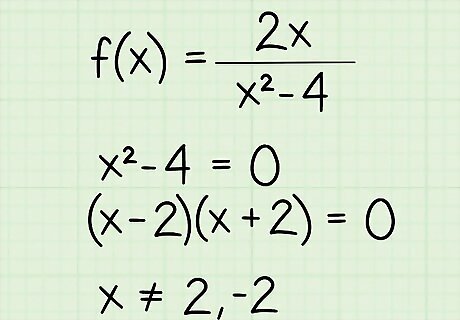
Set the denominator equal to zero for fractions with a variable in the denominator. When finding the domain of a fractional function, you must exclude all the x-values that make the denominator equal to zero, because you can never divide by zero. So, write the denominator as an equation and set it equal to 0. Here's how you do it: f(x) = 2x/(x - 4) x - 4 = 0 (x - 2 )(x + 2) = 0 x ≠ (2, - 2)

State the domain. Here's how you do it: x = all real numbers except 2 and -2
Finding the Domain of a Function with a Square Root
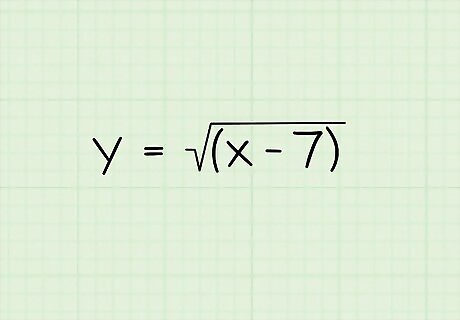
Write the problem. Let's say you're working with the following problem: Y =√(x-7)
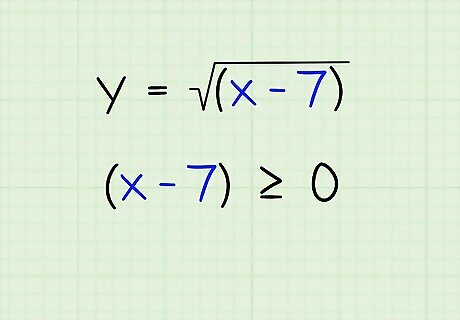
Set the terms inside the radicand to be greater than or equal to 0. You cannot take the square root of a negative number, though you can take the square root of 0. So, set the terms inside the radicand to be greater than or equal to 0. Note that this applies not just to square roots, but to all even-numbered roots. It does not, however, apply to odd-numbered roots, because it is perfectly fine to have negatives under odd roots. Here's how: x-7 ≧ 0
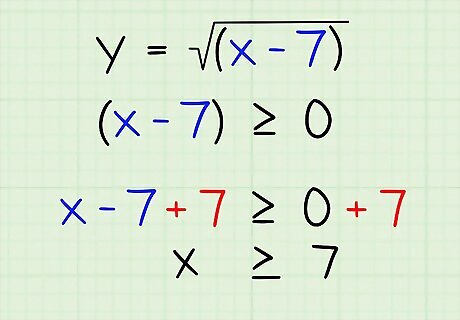
Isolate the variable. Now, to isolate x on the left side of the equation, just add 7 to both sides, so you're left with the following: x ≧ 7 EXPERT TIP Joseph Meyer Joseph Meyer Math Teacher Joseph Meyer is a High School Math Teacher based in Pittsburgh, Pennsylvania. He is an educator at City Charter High School, where he has been teaching for over 7 years. Joseph is also the founder of Sandbox Math, an online learning community dedicated to helping students succeed in Algebra. His site is set apart by its focus on fostering genuine comprehension through step-by-step understanding (instead of just getting the correct final answer), enabling learners to identify and overcome misunderstandings and confidently take on any test they face. He received his MA in Physics from Case Western Reserve University and his BA in Physics from Baldwin Wallace University. Joseph Meyer Joseph Meyer Math Teacher To solve an equation for a variable like "x," you need to manipulate the equation to isolate x. Use techniques like the distributive property, combining like terms, factoring, adding or subtracting the same number, and multiplying or dividing by the same non-zero number to isolate "x" and find the answer.
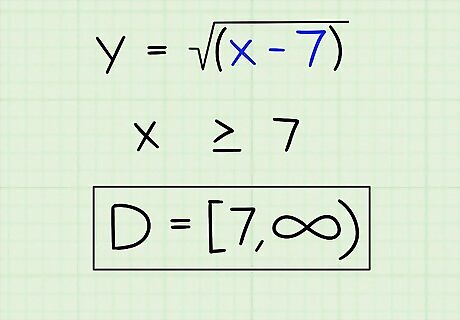
State the domain correctly. Here is how you would write it: D = [7,∞)
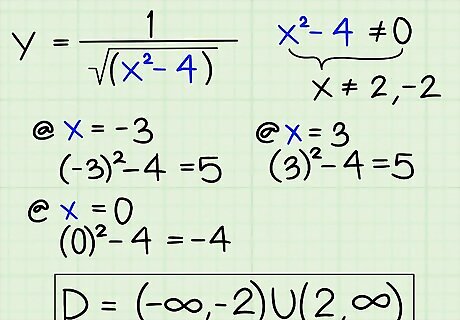
Find the domain of a function with a square root when there are multiple solutions. Let's say you're working with the following function: Y = 1/√( ̅x -4). When you factor the denominator and set it equal to zero, you'll get x ≠ (2, - 2). Here's where you go from there: Now, check the area below -2 (by plugging in -3, for example), to see if the numbers below -2 can be plugged into the denominator to yield a number higher than 0. They do. (-3) - 4 = 5 Now, check the area between -2 and 2. Pick 0, for example. 0 - 4 = -4, so you know the numbers between -2 and 2 don't work. Now try a number above 2, such as +3. 3 - 4 = 5, so the numbers over 2 do work. Write the domain when you're done. Here is how you would write the domain: D = (-∞, -2) U (2, ∞)
Finding the Domain of a Function Using a Natural Log
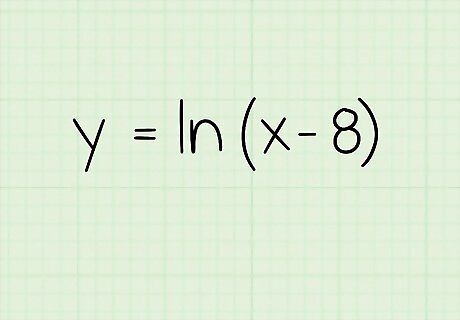
Write the problem. Let's say you're working with this one: f(x) = ln(x-8)

Set the terms inside the parentheses to greater than zero. The natural log has to be a positive number, so set the terms inside the parentheses to greater than zero to make it so. Here's what you do: x - 8 > 0

Solve. Just isolate the variable x by adding 8 to both sides. Here's how: x - 8 + 8 > 0 + 8 x > 8
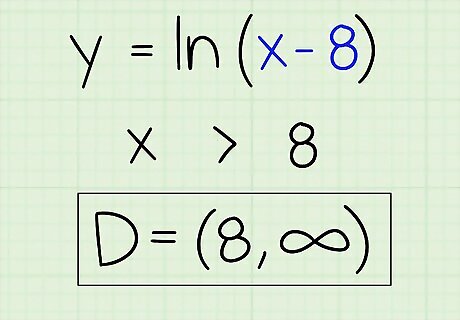
State the domain. Show that the domain for this equation is equal to all numbers greater than 8 until infinity. Here's how: D = (8,∞)
Finding the Domain of a Function Using a Graph

Look at the graph.
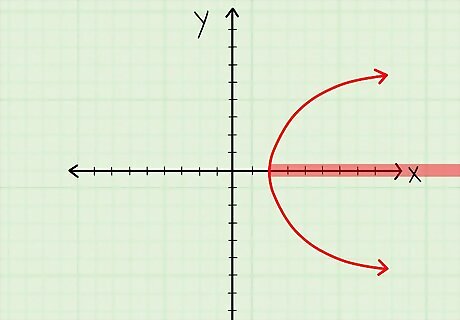
Check out the x-values that are included in the graph. This may be easier said than done, but here are some tips: A line. If you see a non-vertical line on the graph that extends to infinity in both directions, then all versions of x will be covered eventually, so the domain is equal to all real numbers. A normal parabola. If you see a parabola that is facing upwards or downwards, then yes, the domain will be all real numbers, because all numbers on the x-axis will eventually be covered. A sideways parabola. Now, if you have a parabola with a vertex at (4,0) which extends infinitely to the right, then your domain is D = [4,∞)

State the domain. Just state the domain based on the type of graph you're working with. If you're uncertain and know the equation of the line, plug the x-coordinates back into the function to check.
Finding the Domain of a Function Using a Relation

Write down the relation. A relation is simply a set of ordered pairs. Let's say you're working with the following coordinates: {(1, 3), (2, 4), (5, 7)}
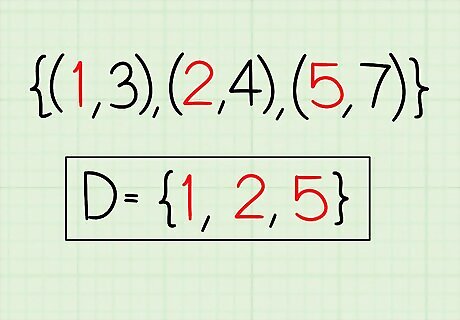
Write down the x coordinates. They are: 1, 2, 5.

State the domain. D = {1, 2, 5}
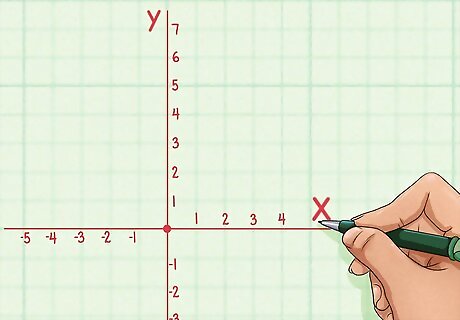
Make sure the relation is a function. For a relation to be a function, every time you put in one numerical x coordinate, you should get the same y coordinate. So, if you put in 3 for x, you should always get 6 for y, and so on. The following relation is not a function because the x coordinate, 1, has two different corresponding values of y, 4 and 5. {(1,4), (3,5), (1,5)}.


















Comments
0 comment